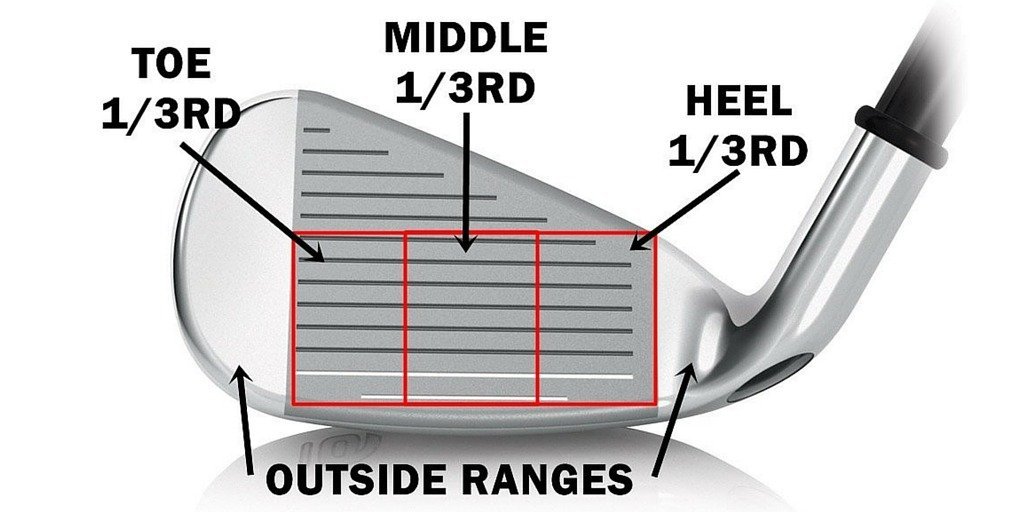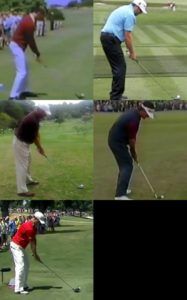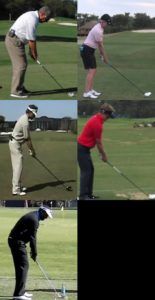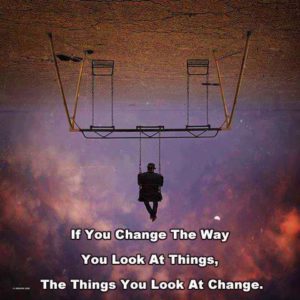
This is a guest post by Adam Young, author of the best-selling book The Practice Manual
When I worked at Turnberry, I once had a blind golfer come for a lesson with me. He was part of the Scottish National Blind Golfers team, and was a pretty decent player. He worked with a different pro at the academy, but this pro had called in sick this day, so I was going to take over.
I didn’t know what to expect as he turned up for his first lesson with me. His caddy came along; he lines him up and gets him set up and ready to go. The guy was like a machine – not very long but reproduced very similar clubhead and ball contact each time.
He was stating that his shots didn’t feel great, and I could see that he had a heel biased pattern with the strikes.

The Change
As this golfer wasn’t my pupil (he was the pupil of the sick pro), I didn’t want to mess around with his swing too much as I could open up a can of worms, especially having never dealt with this situation before. So I decided to do a sneaky quick fix.
His caddy got him set up, and then I jumped in and moved the ball about an inch towards the toe.
BAM
His first shot was flushed – “That felt different”, he stated.
He then continued to hit shots with a better quality than before, and it wasn’t surprising to see the same range of strike shift more centered – about 1 inch to be exact.
People may think that it is really dishonest to make him set up in a way that is not ‘textbook’, but some of the top pros in the world earn millions doing that.


I often change set up position from day to day to try and get the strike I need. The question here is, do you want to look good and shoot a 90, or do you want to get it around the course under par?
Where it Gets Interesting
But I, and other professionals who have taught enough, will know that this type of fix does not work with the average golfer. Rather than just ‘know’ this, I set out to test it and get numbers.
The Experiment
Last year, I had a lot of lessons which came with poor strike patterns. Sure, they were very consistent patterns (tight range, but toe or heel biased), they were just consistently poor.
What I tested
I aimed to see if I could get these players to instinctively shift their strike patterns into a better location. In order to measure it, I looked at three things:
- How many shots could they get inside the middle 1/3rd of the clubface
- How many shots they could get in the opposing 2/3rds to their strike tendency (showing changeability)
- How many shots were outside range (not on the grooved part) i.e. toe or heel shanks

The Entry Criteria
I only did this with certain people – ones who had a score of 2 or less out of 10 shots for middle 1/3rd of clubface strike. So these people had a very clear and strong pattern.
Luckily, I had no shortage of people eligible for the study. I managed to get 20 people (2 groups of 10) very quickly. Lots of these were good players too – some lower than 15 handicap – so make sure you check your own strike patterns.
The Intervention
I asked;
Group 1 - Set up out of the opposing 1/3rd of the clubhead for me and feel as if they were a little farther/closer to the ball. E.g. heel biased players were to set up out of the toe and stand farther from the ball, toe biased players to set up out of the heel and stand closer.
Group 2 – Set up normally, but TRY to hit the other 1/3rd of the club
We then hit 10 shots and noted the results.
What Happened?
The result shocked me a little. They were as I expected in terms of what happened, but the magnitude of difference shocked me.
Group 1 - The Set Up Shifters
Not only did this group improve less than group 2, but some of them got worse. We will go through why later in the article.
Group 2 - The Mind Shifters
This group changed the strike pattern much more, and scored more sweet spot strikes and more changed pattern shots. Also, they greatly reduced the number of shots which were outside of acceptable ranges (toe or heel shanks).

The Results Summary
From the above results we can see that
- Everyone improved their ability to move the strike more centered.
- The mind shifters (people who tried to hit a different part of the face) showed much bigger improvements
- There were very few strike changes which were overdone in both groups – showing the strength of attractor states
- Group 1 (set up shifters) actually showed an INCREASE in poor shots
- If you take the number of improved strikes and minus the number of worse strikes, we see that
- Group 1 only showed an 11% improvement/change in patterns
- Group 2 showed a 67% improvement/change in patterns
- As an ‘outside of the boundaries’ strike is usually far more costly, this is not good news.
But...That Shouldn't Happen
Being logical, it would make sense that group 1 should improve every shot. If you took a robot which was hitting it from the toe and set it 1 inch closer, the whole pattern should shift 1 inch more towards the centre. That was also the case in my blind golfer. So, why did group 1 not see the same results? How on earth could some of them even get worse?
Put yourself in their shoes
Imagine you are asked to hit the sweet spot of the club, but you are told to stand closer to the ball. (I.e. you normally have a toe biased pattern). What do you feel?
You are going to think “Jeez, I feel a lot closer than normal, this feels cramped. I feel like I am going to shank it from here”.
This uncomfortable feeling is then going to seep into your movement. As a result your body instinctively tries to get farther from the ball to make enough space to swing the club closer to you.
The issue is that you already have this move of getting the swinging too close to you though impact. Combine the two together and not only does it cancel out the fact you stood closer, but it may even cross over the boundary of where you were before.
This is why lots of our group 1 saw an increase in poor shots.
Perception Shifts
The reason this happens for sighted golfers and not for robots or blind golfers is that, sighted golfers have a visual perception. They see where the ball is and their brain has coded algorithms for returning the sweet spot to the ball in a certain way. We call this perception-action coupling of club Centre of mass and ball centre of mass. A mouthful I know.
And these algorithms in the brain are the strongest attractor state of all – our biggest intention as a golfer is for us to hit the ball in the best way we know.
For this reason, I have seen shankers stand ridiculously far away from the ball in an attempt to avoid hitting the heel, but to no avail. They are missing a vital element to the change – the perception change.

By asking players to try and hit a different part of the clubface, we created a shift in their perception.
Isn't This Just a Quick Fix?
You might think so, if you looked only at the surface. But it could easily be argued that a technical fix is more of a quick fix.
A technical fix doesn’t deal with the concept. Forcing yourself to make a new move might get you the results you desire initially, but your body may try to find its way to the old attractor state (old strike pattern) by adding in other variables.
For example, If our group 1 had just set up in the new way and made the exact same swing, they would have seen HUGE success in pattern shifts. But they didn’t – so they must have technically added in moves which got them back to their old strike pattern (attractor state).
If you have ever had a swing tip which fixes your shanks, only to have them come back again – this is the reason. You didn’t make a strike perception shift, you simply forced a position without the correct movement intention.
A swing style fix alone also doesn’t deal with a player’s ability to shift the strike around the face. This is a vital skill to have to be able to calibrate your own performance from day to day or even shot to shot. Eventually, this skill itself becomes automatic and leads to autocorrection abilities.
And it is NEVER a bad idea to improve your ability to be able to hit whichever part of the clubface you want at will.
Skills for Life
Also, when you have this SKILL, it stays with you for life. That doesn’t sound like a short term fix to me. It also is a transferable skill – it stays with you as the technique changes. So that means that if you now decide to make a change in your swing style to make it more efficient/technically better, you also have the ability to re-calibrate the strike should it shift unfavorably.
This also means that as you age/ get injured/ swing evolves for other reasons, you will be able to make it work. When I injured my legs after my marathon, I was unable to swing in the same style. Yet, due to my skill at shifting my perception, I was quickly able to get a functional ball flight.

Also, improving this skill through improved perception results in more adaptability. When the lie changes, when the wind is different, or when you change clubs and require a different set of forces, torques, body planes, club planes etc, the ABILITY stays with you.
Not Black and White
Do not misunderstand what I am saying. At no point have I said that technical/swing style fixes are unnecessary, irrelevant, not helpful etc. On the contrary – technical fixes can massively increase your ability to do certain things. They can also open up a larger margin for error, resulting in the need for less skill/ability to shift strike patterns.
For example, a player with an extremely open/closed face to path would have a much more difficult time regarding hitting the middle of the face than someone with a squarer face to path. This is the idea behind increasing technical consistency.
But you shouldn’t use technical fixes alone to improve your technique (sounds silly, I know). Skill based and perceptual based changes not only improve skills themselves (skills are abilities), but the techniques come along for free, are adaptable and more robust.
What this means for you
- We cannot underestimate the importance that the mind and our perceptions play in our ability to create the shot we want.
- What may seem like a quick fix may actually be one of the most robust and longest lasting fixes of all.
- Our impact is the strongest attractor state of all.
- Using differential practice and variability practice modes can greatly affect our conscious perceptions.
- Using constraints led approaches can greatly affect our subconscious perceptions.
- Technical/swing style changes can certainly make a difference – but if you find you are constantly reverting back to your old impact, you might need to make a change on a deeper level. Mechanics are usually a symptom of something else.
- Making a shift in perception is not the same as leaving mechanics alone. Perception shifts can and will affect mechanics.
If you want to learn more about skill development, perception, practice modes and alternative ways of learning this game rooted in motor learning science, my book “The Practice Manual – The ultimate guide for golfers” is available from Amazon – click below to find out more...

We care about the protection of your data Read our Privacy Policy